21 Smart Medicine Cabinet Organization Ideas for 2025
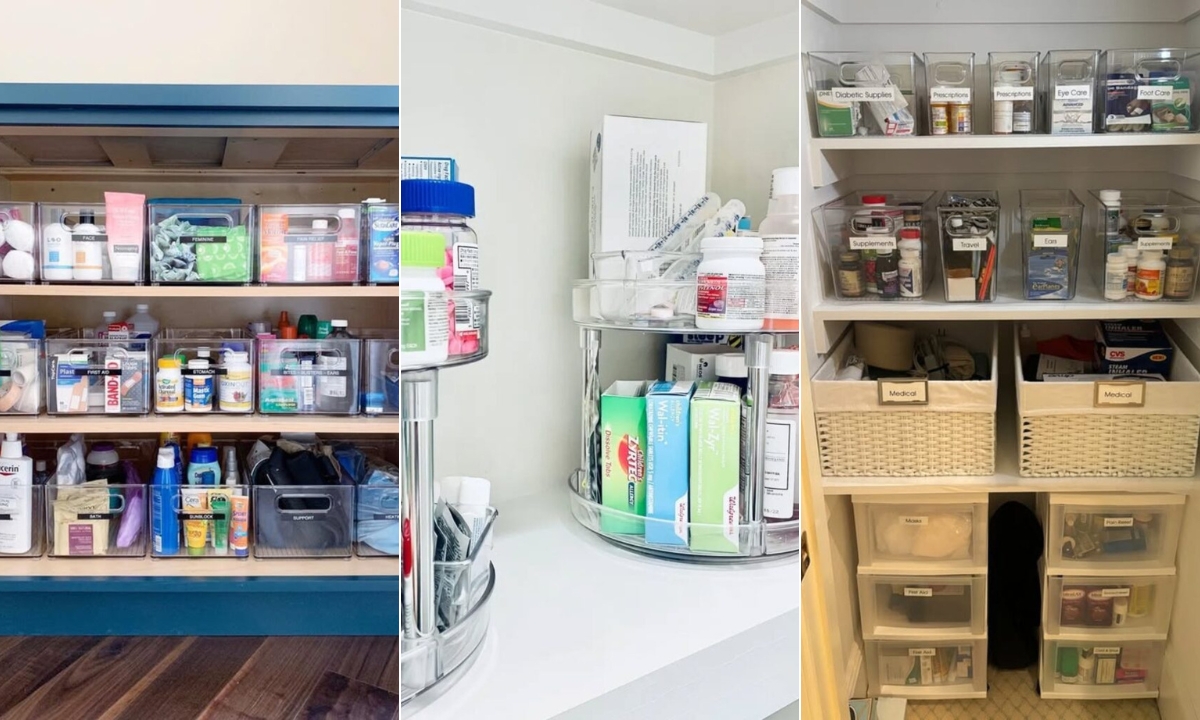
When you really need something like a fever reducer in the middle of the night or antiseptic after a cut, you end up wasting time searching through expired or misplaced items.
On top of that, storing things carelessly can put them within reach of children, and bathroom humidity can ruin medicines long before they expire.
This is why it is time to reset your medicine cabinet.
With a simple system, smart storage ideas, and a few safety steps, you can turn that messy box into a space where everything is fresh, easy to find, and safe for your family.
In this guide, I will show you exactly how to do it.
Contents
- 1 Why Your Medicine Cabinet Isn’t Working?
- 1.1 Rotate with Lazy Susans
- 1.2 Use Tiered Risers for Small Bottles
- 1.3 Label Clear Bins by Category
- 1.4 Sort Pills into Labeled Cases
- 1.5 Line Up with Shelf Organizers
- 1.6 Divide Supplies with Sectioned Bins
- 1.7 Separate Kids’ and Adults’ Medicine
- 1.8 Dedicate Shelves by Health Need
- 1.9 Create Zones with Mixed Storage
- 1.10 Use Family-Specific Bins
- 1.11 Label Every Category Clearly
- 1.12 Stack Lidded Boxes for Categories
- 1.13 Add a Lockable Box for Safety
- 1.14 Keep Everything in Lidded Bins
- 1.15 Use Small Bins for Tall Bottles
- 1.16 Use Uniform Bins for a Clean Look
- 1.17 Maximize Space with Tiered Turntables
- 1.18 Use Chalkboard Labels for Flexibility
- 1.19 Stack Drawers for Tight Spaces
- 1.20 Group by Health Category
- 1.21 Store Bottles Flat in Drawers
- 2 FAQs
Why Your Medicine Cabinet Isn’t Working?
Take a moment to look at your medicine cabinet. If it looks more like a junk drawer filled with half-empty bottles, old prescriptions, and cluttered boxes, it is not serving its purpose.
The bathroom environment makes things worse.
Steam from hot showers can cause your medicine to lose its effectiveness faster, meaning even pills that appear normal might not work when you need them.
When everything is jumbled together, you waste precious time searching for the right item when someone is sick or injured.
You also create a major safety hazard if you store medicines where children can easily get to them.
Even adults can grab the wrong medication when prescriptions for different family members are stored in the same messy space.
If you want your cabinet to be a reliable resource, you need to stop treating it like a storage closet and start organizing it like an important tool for your family’s health.
Save this article for later! 👇👇
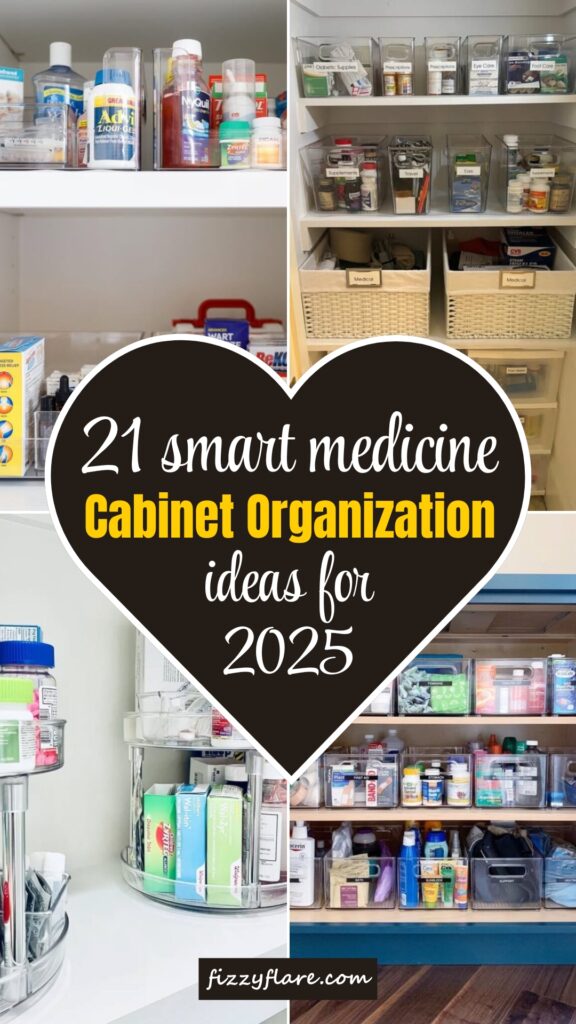
Rotate with Lazy Susans
A lazy Susan helps you easily manage even the deepest shelves. This method is great for medium or large cabinets where bottles often get pushed to the back.
To set this up, pick clear turntables so you can see the labels easily.
Add simple labels for categories like “Pain Relief,” “Allergies,” or “Prescriptions.”
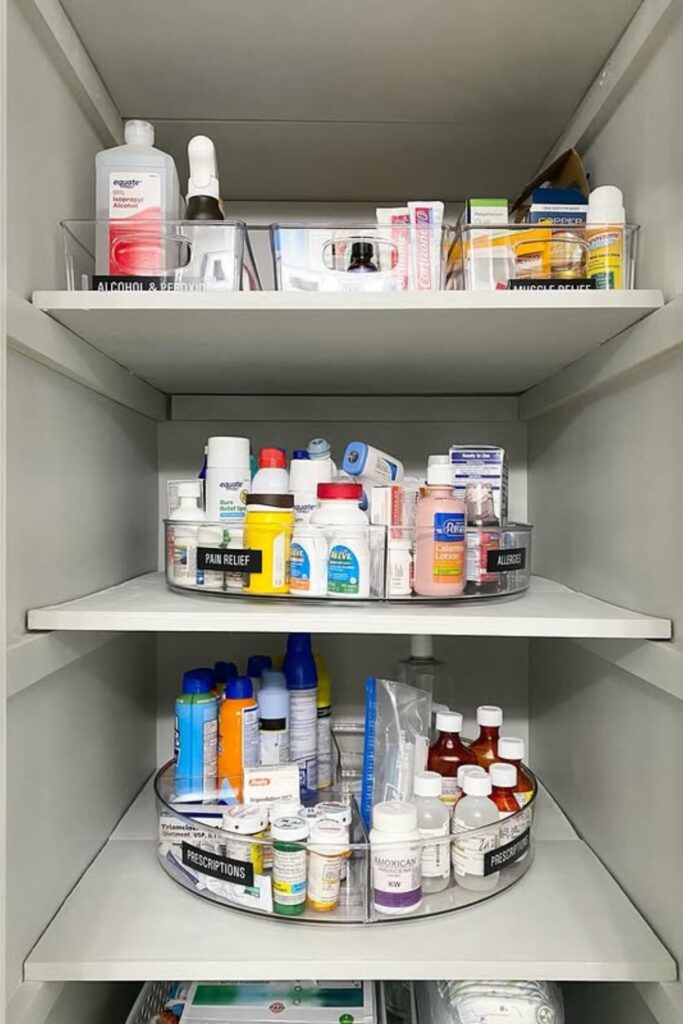
Use Tiered Risers for Small Bottles
Small bottles, like those for vitamins or essential oils, can easily get lost when you store them on a flat surface.
A tiered riser is perfect for shallow cabinets because it makes every bottle visible.
To do this, put a clear riser on a shelf and arrange your bottles by type or purpose, for example, daily vitamins in one row and oils in another.
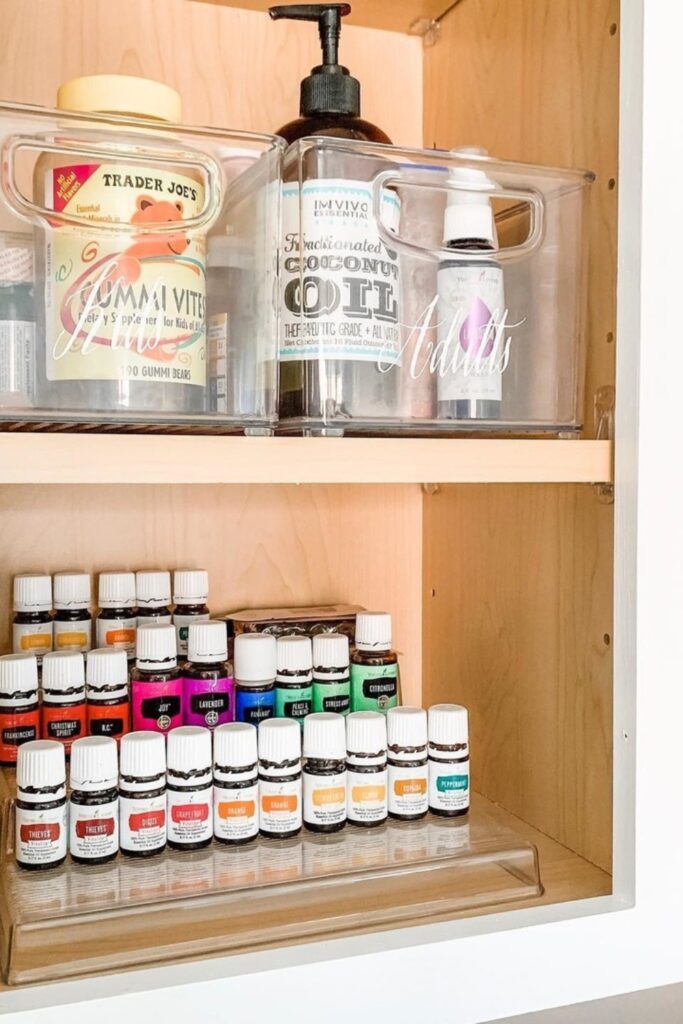
Label Clear Bins by Category
Instead of stacking boxes, sort your items into clear bins with bold labels like “First Aid,” “Pain Relief,” or “Masks & Gloves.”
This works well in larger cabinets where you have several shelves to keep supplies separate.
To set this up, pick stackable bins with handles. This lets you pull one out and see everything inside at a glance.
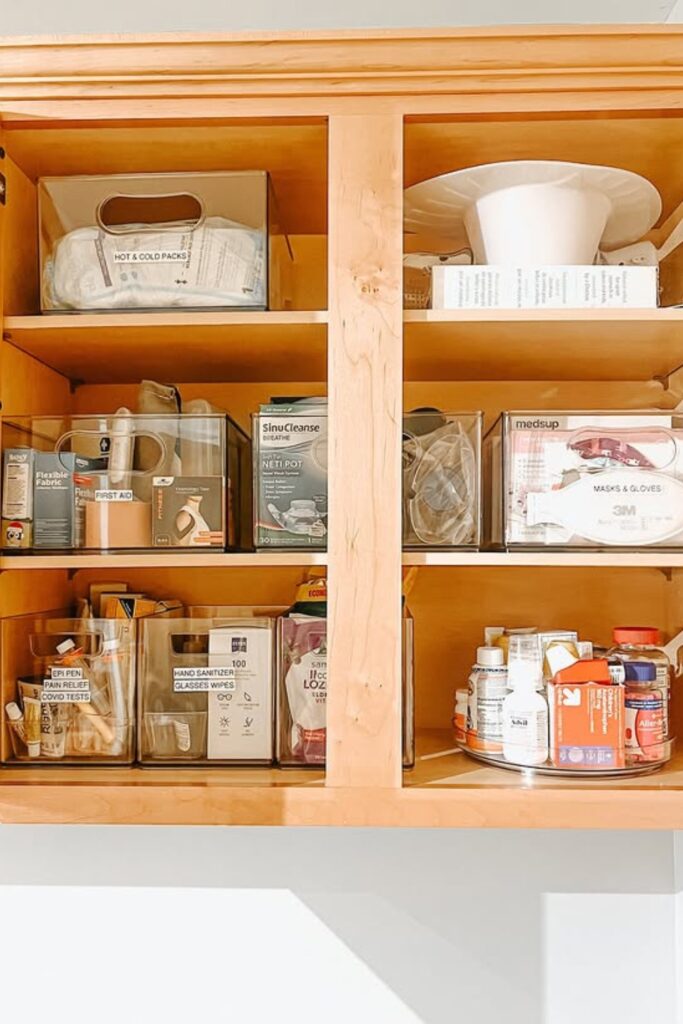
Sort Pills into Labeled Cases
If you are tired of dealing with large pill bottles, use thin pill cases with labels for each medicine.
This method is great for saving space inside baskets or drawers.
To do this, move your pills into secure, airtight cases and label each one with the medicine’s name.
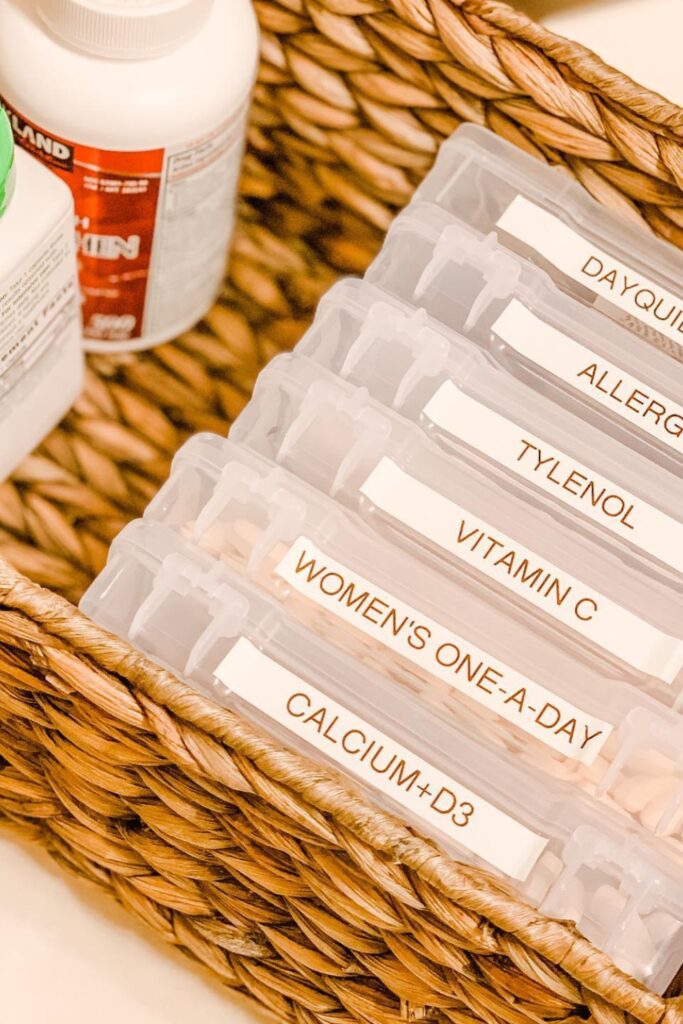
Line Up with Shelf Organizers
If you have many supplement bottles, a tiered shelf organizer helps you see them all instead of letting them get lost behind one another.
This idea is great for wide cabinets where you need to fit bottles of different sizes.
To set this up, you can use expanding tiered risers. Place the items you use daily in the front row and move extra supplies to the back.
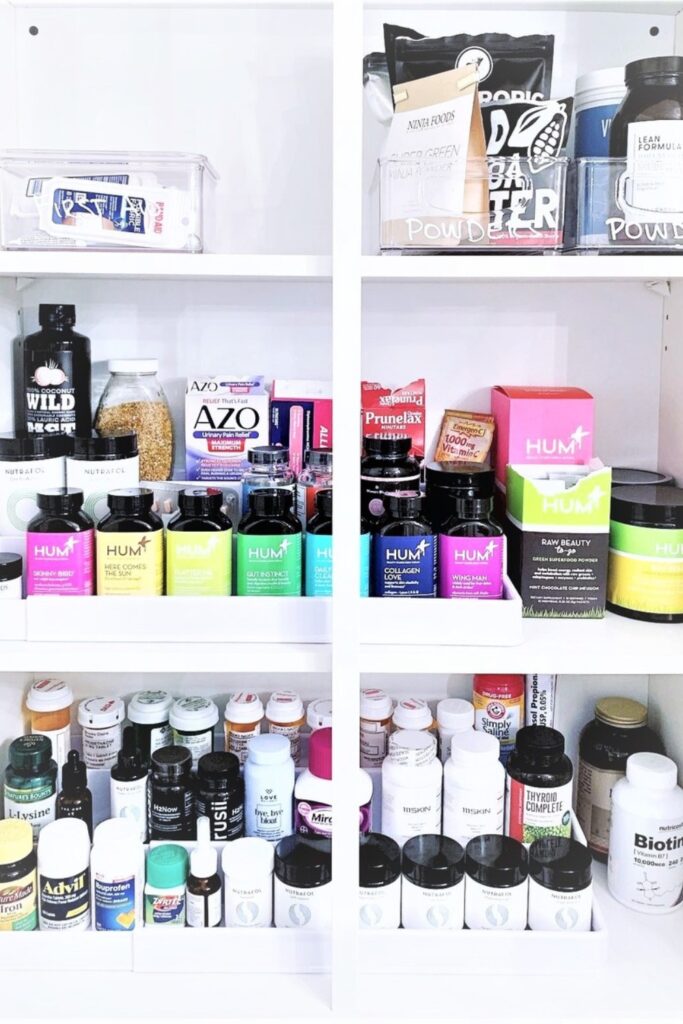
Divide Supplies with Sectioned Bins
When you have a mix of bottles, creams, and first-aid items, sectioned bins keep everything tidy and easy to find.
This works well on deep shelves where things often get pushed to the back. To do this, pick clear bins that have dividers inside.
You can group items by their use, put cold medicine in one section, bandages in another, and vitamins in a third.
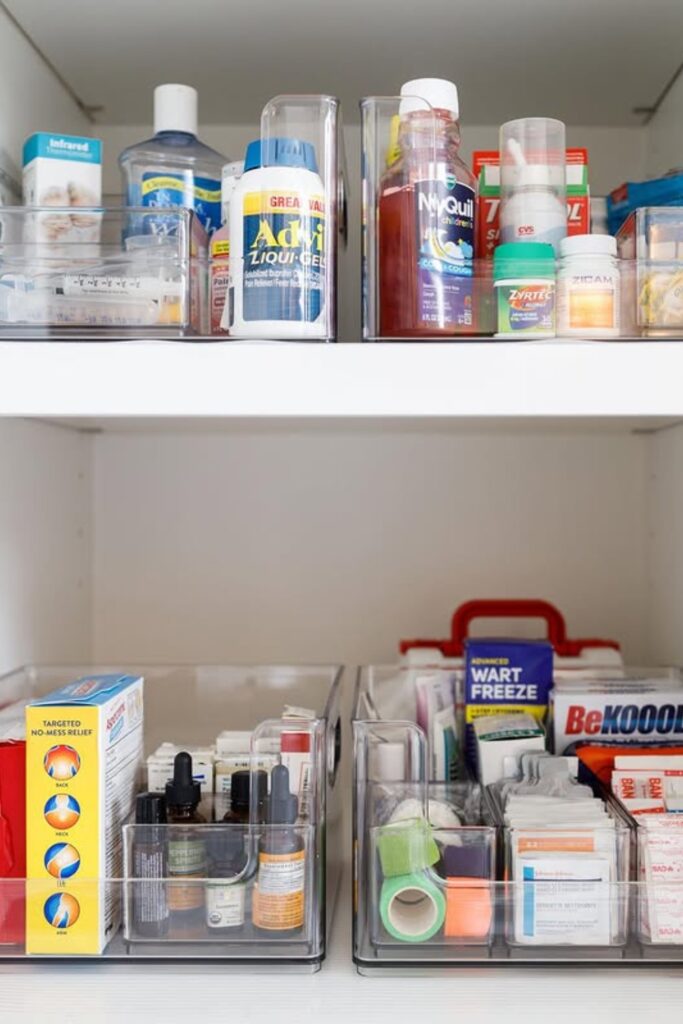
Separate Kids’ and Adults’ Medicine
Storing children’s and adults’ medicine together can lead to dangerous mix-ups.
To prevent this, you should use separate bins for each. This system is most effective on open shelves where you can easily see the labels.
You can set this up using clear bins with bold, easy-to-read labels like “Child Cold,” “Child Fever,” “Adult Cold,” and “Adult Other.”
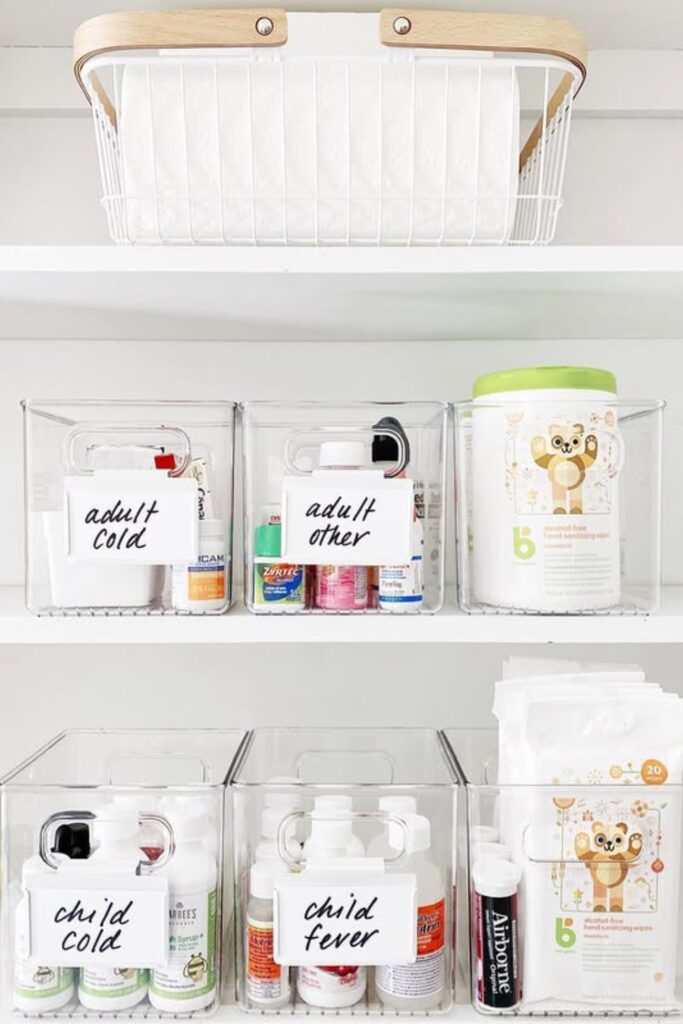
Dedicate Shelves by Health Need
A medicine cabinet is most useful when you give each shelf a specific purpose.
This organization method works very well if you have tall cabinets with several shelves available.
To do this, place clear bins on each shelf and label them by health need, such as “Respiratory,” “Children’s Fever,” “Bandages,” or “Baby.”
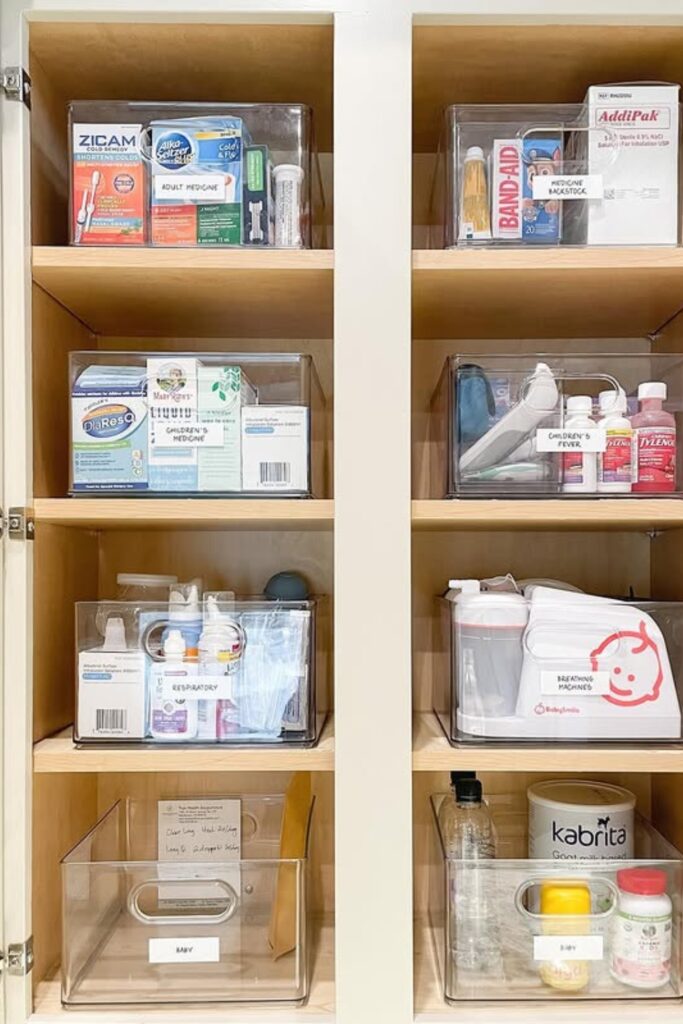
Create Zones with Mixed Storage
If you are organizing a tall cabinet or closet, divide it into zones so every item has its own place.
This method works best in larger spaces where you need to meet the needs of the whole family.
To set it up, use clear bins for smaller items like prescriptions, supplements, and eye care products. For larger medical supplies, switch to woven baskets.
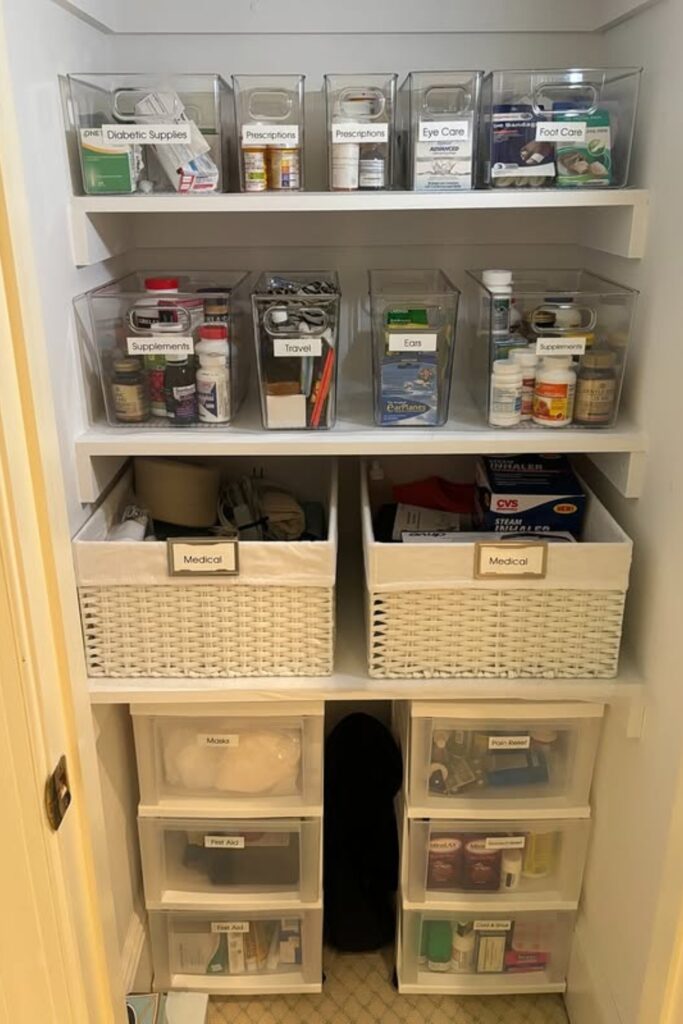
Use Family-Specific Bins
To avoid mix-ups, separate medicine by age group. This system is especially helpful for families with children who need their own dosages and brands.
To set it up, use clear bins with bold labels like “Adult Cold,” “Child Fever,” or “Adult Other.”
Keep items like wipes or thermometers in their own bin for quick access.
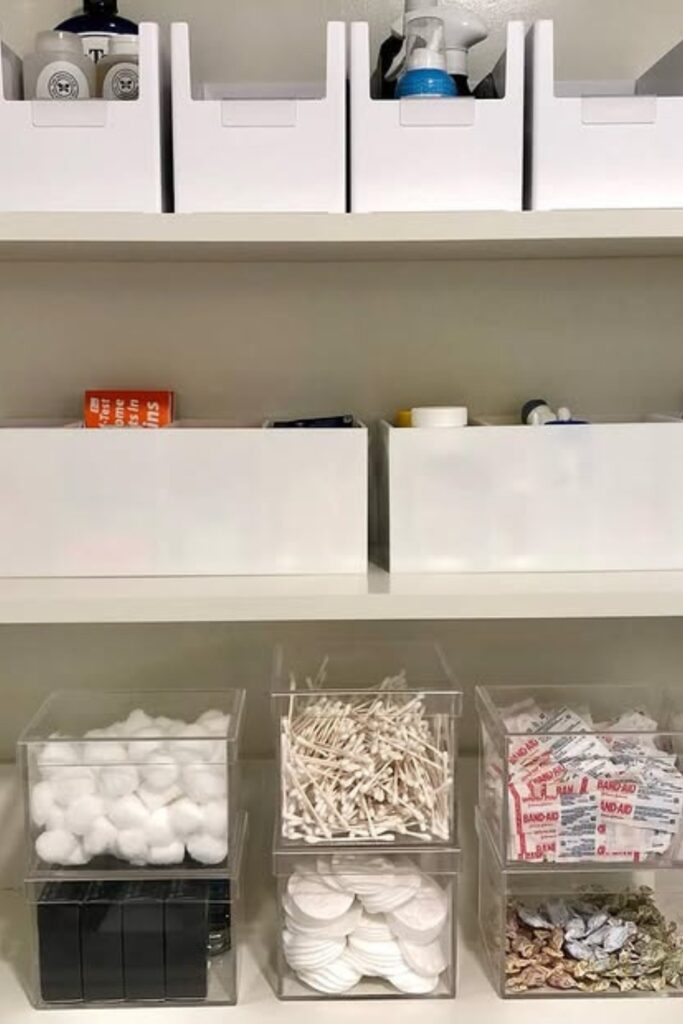
Label Every Category Clearly
If you store different kinds of medicine in one cabinet, clear labels will help you keep everything organized.
This system is great for busy homes where several people share the same space. To set this up, get some narrow, clear bins.
Then, add bold labels like “Cold & Flu,” “Allergies,” “Pain & Fever,” or “Electrolytes.” You can put probiotics and kids’ vitamins on a lazy Susan on the bottom shelf.
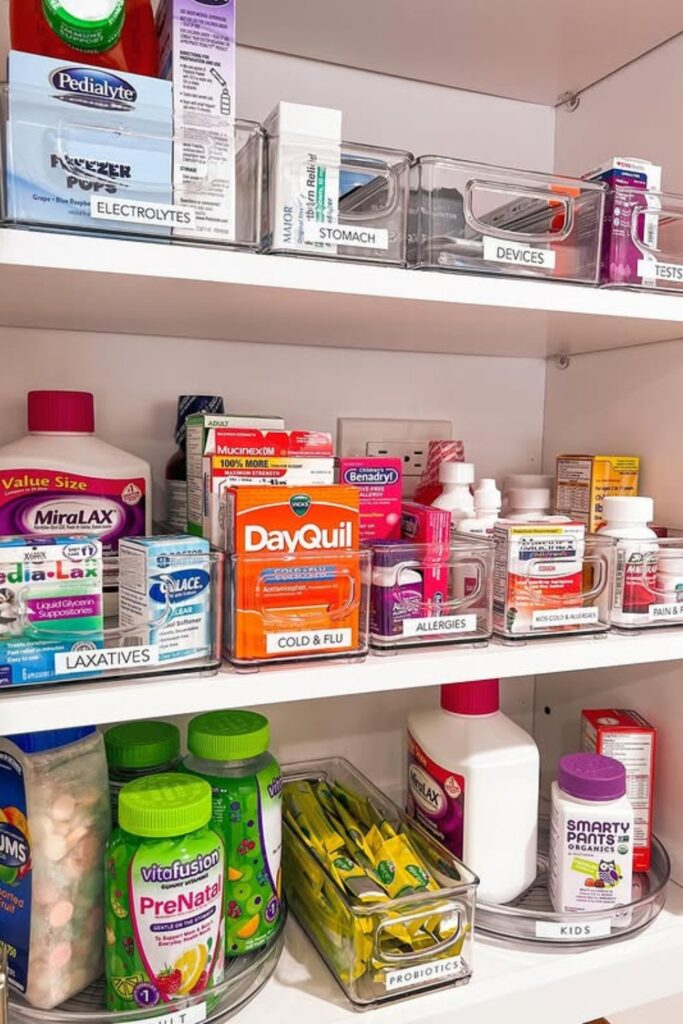
Stack Lidded Boxes for Categories
When you have a deep cabinet and want to keep items free of dust, you can stack boxes with lids. Make sure you label them clearly.
This approach is perfect for closets or large shelves where you store extra supplies you do not use often.
To do this, find some light plastic boxes with lids that snap shut. Print simple labels like “Cold & Allergy,” “Stomach & Sleep,” or “First Aid.”
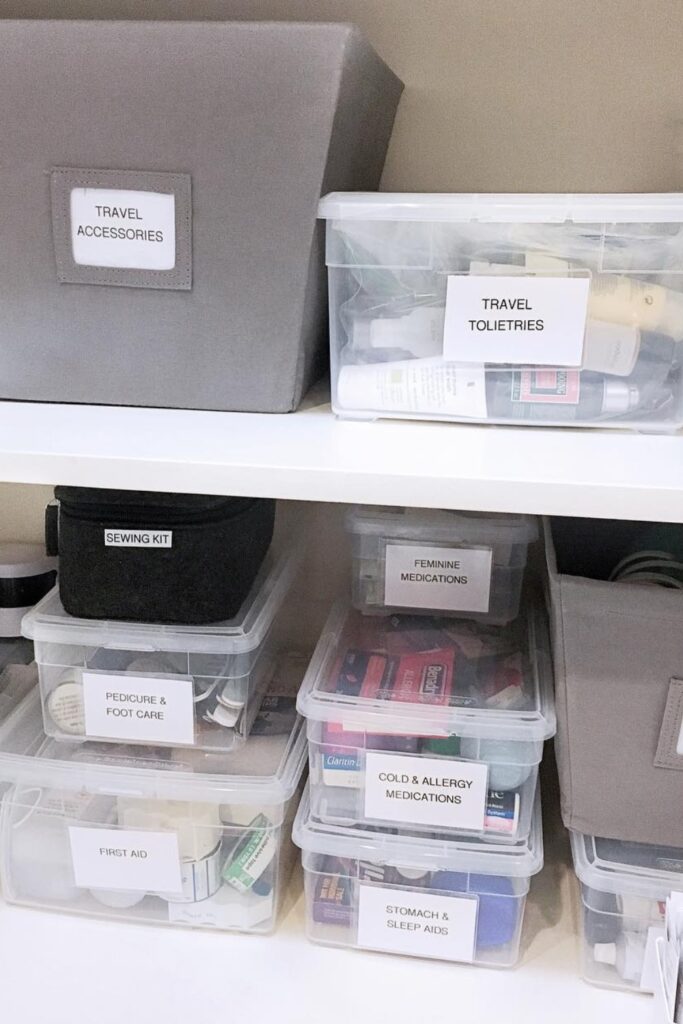
Add a Lockable Box for Safety
If you store prescriptions or strong medicines in your home, a lockable box provides an important layer of safety.
This approach is especially useful for households with children or in shared homes where you need to control access.
This method helps you balance security with convenience, ensuring no one can access medicines unsafely.
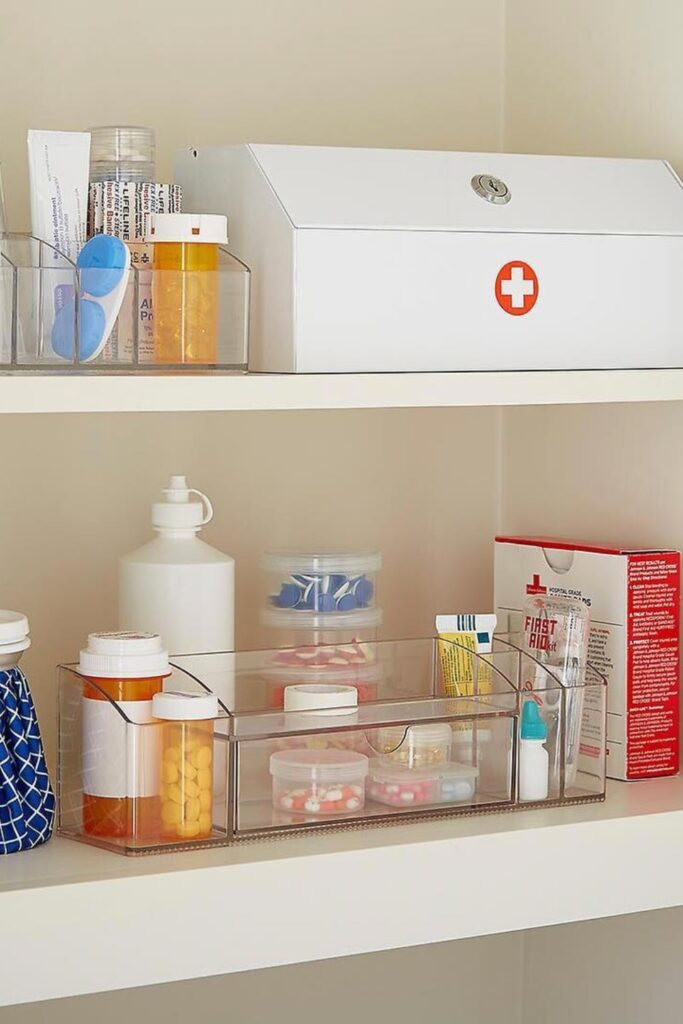
Keep Everything in Lidded Bins
Using bins with lids stops clutter from taking over and helps you sort supplies by purpose.
This system is great for cabinets that you want to keep dust-free or when you prefer a clean, uniform look.
To do this, get some lightweight plastic bins that have snap-on lids.
You can then write or print labels for categories like “Throat,” “Digestive,” “First Aid,” or “Cold & Cough.”
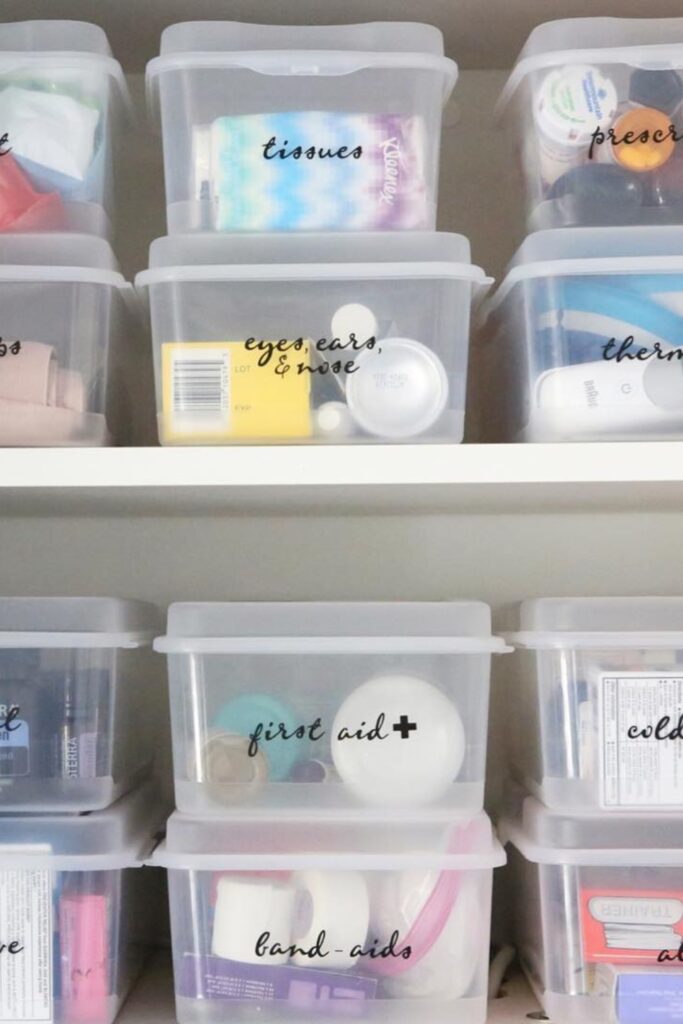
Use Small Bins for Tall Bottles
Tall medicine bottles and sprays can easily tip over if they are left loose on a shelf.
Small clear bins are a simple solution to keep them upright and organized.
This method works well in narrow cabinets where you want to prevent items from sliding around.
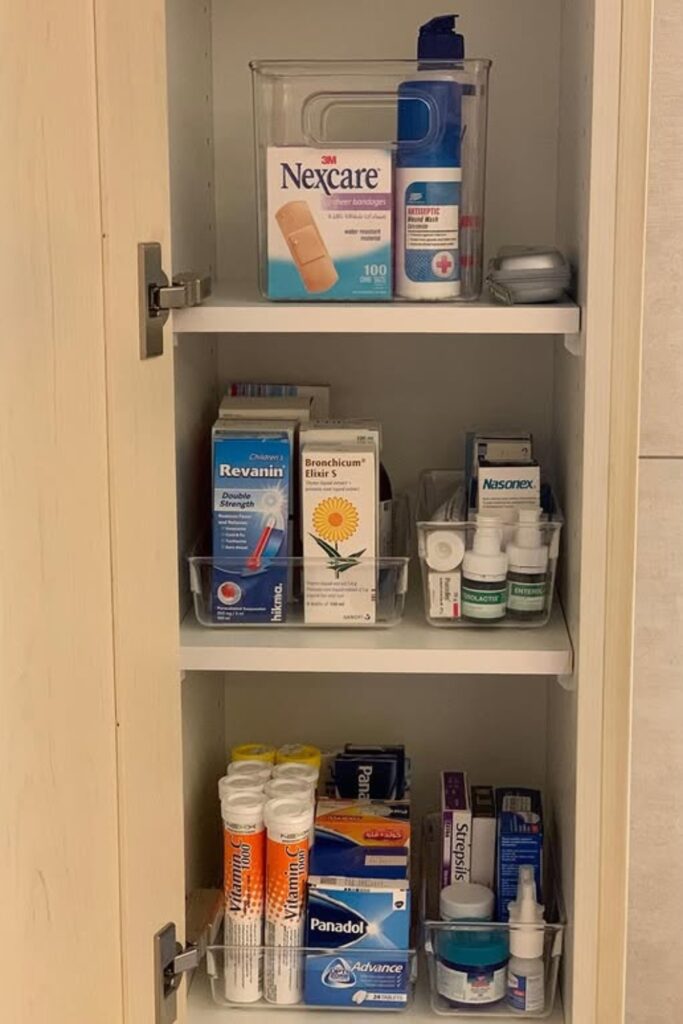
Use Uniform Bins for a Clean Look
If you want your cabinet to look neat and organized, use the same type of bin for every category.
This works best on large shelves where you store medicine for different needs.
The uniform containers keep the cabinet tidy, and the labels make it easy to find what you need in a hurry.
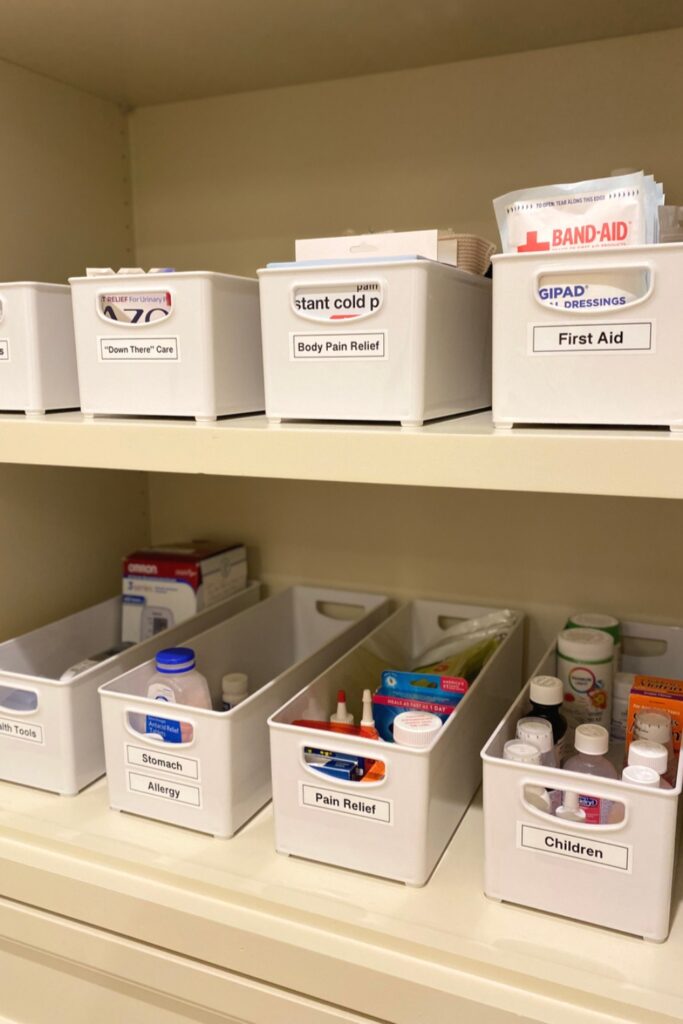
Maximize Space with Tiered Turntables
If your cabinet is small but packed with items, tiered turntables can help you use vertical space efficiently.
They work best in corner shelves or deep cabinets where bottles tend to get lost in the back.
To set this up, use double-layer lazy Susans and organize by size.
Place smaller items like eye drops and pills on the top, and keep larger boxes or syrups on the bottom.
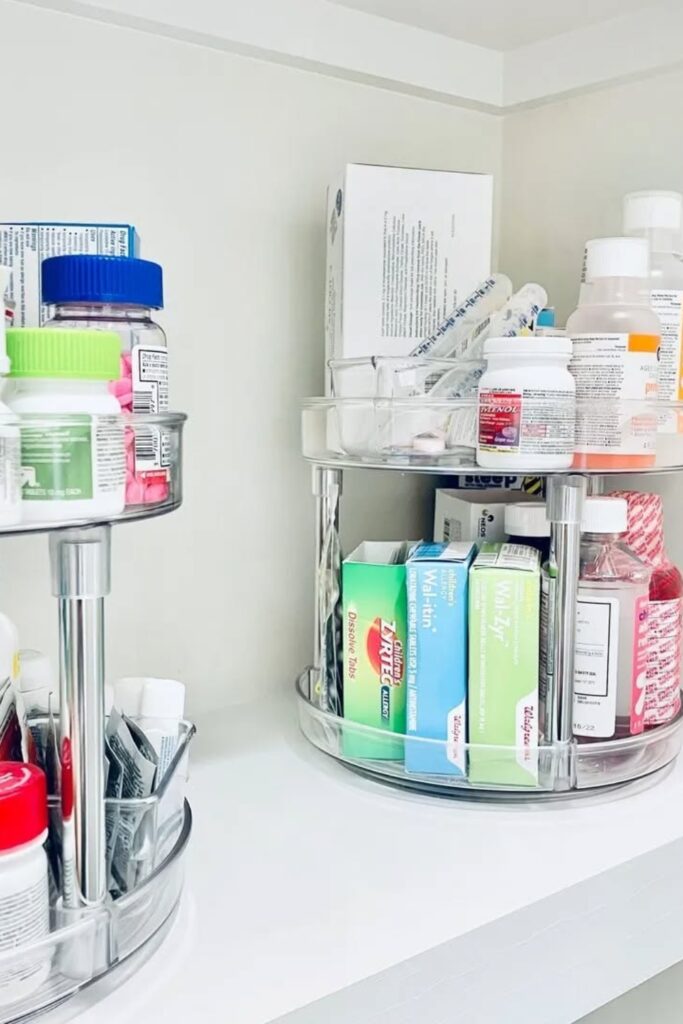
Use Chalkboard Labels for Flexibility
If you like to reorganize your cabinet often, chalkboard labels make it easy to update your system.
This is especially helpful for families whose needs change with the seasons, like swapping cold medicine in winter for allergy medicine in spring.
To try this, attach small chalkboard tags to clear bins and group items by purpose, such as “Stomach,” “Pain Relief,” or “First Aid.”
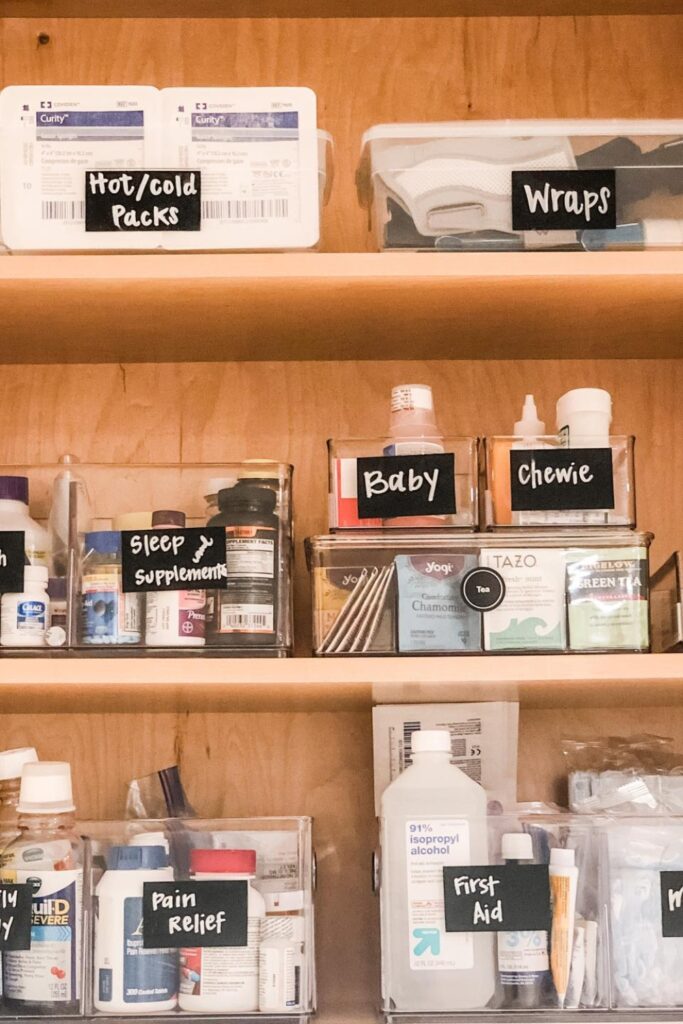
Stack Drawers for Tight Spaces
If you are organizing under a sink or in a narrow cabinet, stackable drawers are a great way to use vertical space.
This setup works well in areas with plumbing pipes where regular bins do not fit.
To create this, use clear drawers and label each one by category, such as “Pain,” “Cold and Flu,” “Allergy,” or “First Aid.”

Group by Health Category
A wide cabinet can quickly become cluttered, so assign each bin to a specific health category.
This method works best on broad shelves where you can line up several clear containers side by side.
Use matching bins with front labels like “First Aid,” “Stomach,” “Cold and Flu,” or “Dental.”
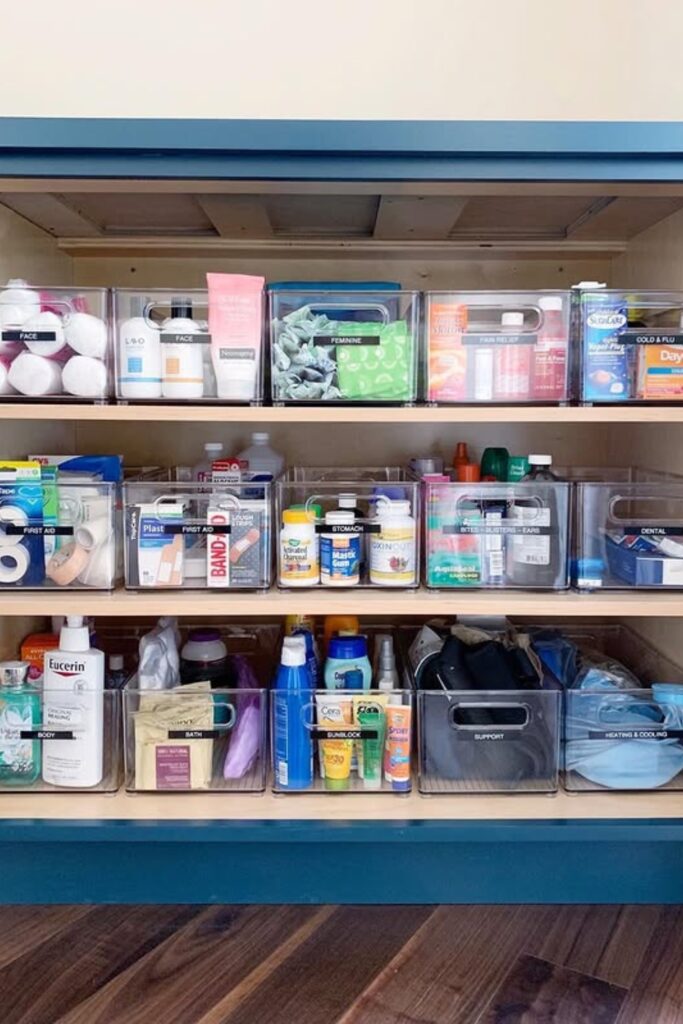
Store Bottles Flat in Drawers
If you have extra drawer space in your kitchen or bathroom, use it to organize your bottles.
Lay them flat so you can read the labels at a glance. This setup is perfect for keeping daily supplements or vitamins within easy reach.
To do this, line the drawer with bottles side by side. If needed, label the tops for quick identification.
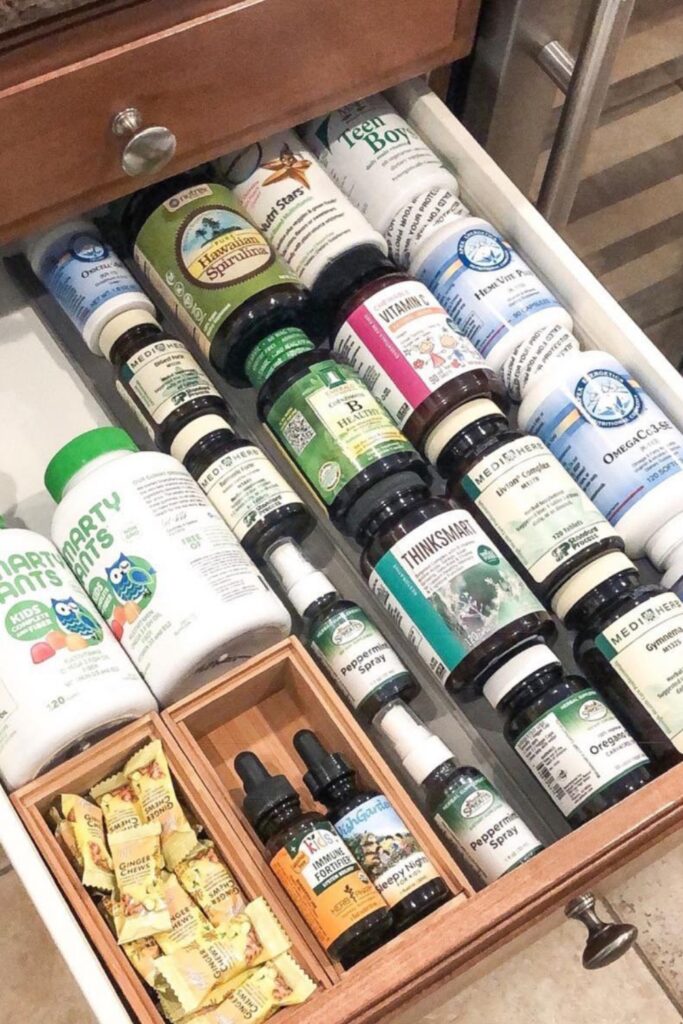
FAQs
How often should I clean out my medicine cabinet?
You may check your medicine cabinet every three to four months.
This gives you enough time to find expired prescriptions, half-used bottles, or empty boxes that are just taking up space.
If you store everything in bins, the cleanup will only take a few minutes.
Think of it as a seasonal reset of fresh supplies, no clutter, and a clear idea of what you have before you need it.
What medicines should never be stored in the bathroom?
Most medicines should not be kept in the bathroom because heat and steam can make them expire faster.
Pills, capsules, and chewable tablets lose their strength more quickly in humid conditions.
Store them in a cool, dry place like a hallway or bedroom closet.
You may also like to read!
- 20 Refrigerator Organization Ideas That Actually Work in 2025
- 5 Car Trunk Organization Hacks That Make Life Easier in 2025
- 4 Genius Kids Organization Hacks Every Parent Needs in 2025

Fasial is the founder of the Fizzy Flare. He has been a passionate blogger since 2021. He ran three different websites in the past few years. Now he is focusing on Fizzy Flare to build an audience and help them organize their life.
